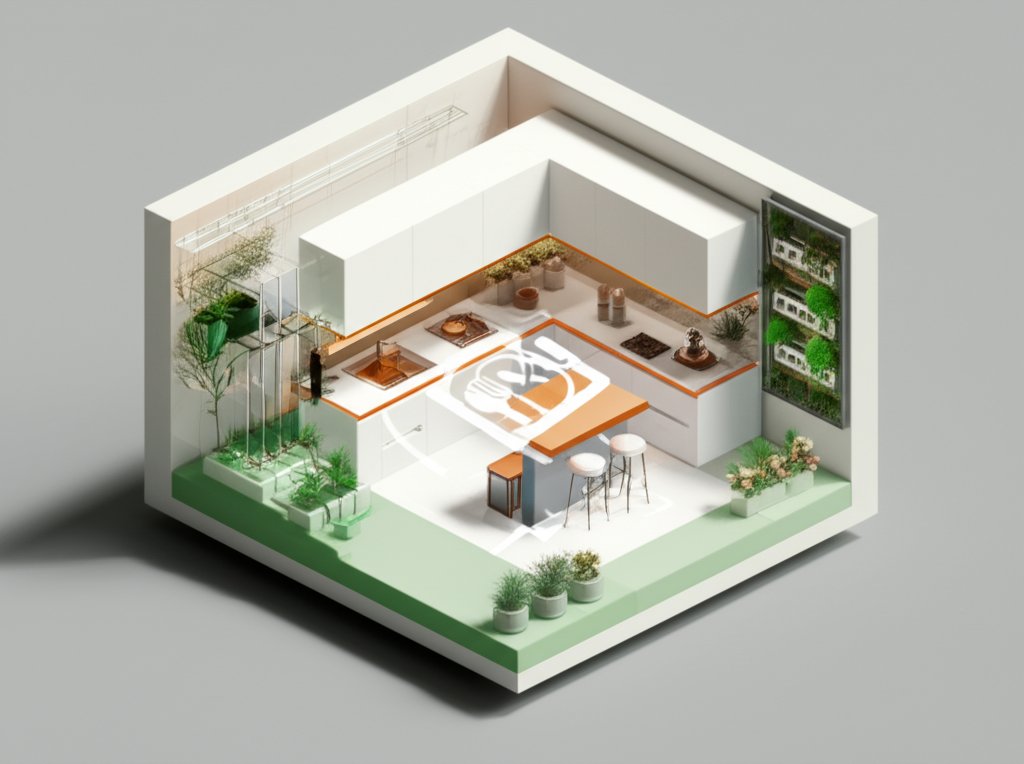Finding the right balance between food prep space and a dining area is crucial, especially in smaller kitchens. Cleverly designed small kitchen island dining table combo ideas offer a functional and stylish solution, maximizing every square inch.
At a glance:
- Discover space-saving design options for combining a kitchen island and dining table.
- Learn how to choose the right materials and dimensions for your needs.
- Get practical tips for incorporating storage and optimizing seating.
- Understand how the island’s design impacts the overall kitchen cost.
- Explore different configurations to suit various kitchen layouts.
Maximize Space with a Dual-Purpose Island
The beauty of a kitchen island dining table combo lies in its ability to serve multiple functions. But before diving into styles, assessing your needs is key. Consider how many people you need to seat regularly, your typical food preparation style, and the overall flow of your kitchen.
For instance, a couple might prioritize a larger prep area with a small, attached breakfast bar, while a family might need a more substantial dining space integrated into the island.
Design Options for Small Kitchen Island Dining Table Combos
Several design strategies can effectively merge an island and dining table, even in tight spaces:
- Built-in Dining Table: Creates a seamless extension of the island countertop, offering a cohesive look. The dining surface can be the same height as the island or slightly lower for comfortable seating.
- Drop-Leaf Table: A fantastic space-saver! When not needed, the drop-leaf folds down, creating a compact island. When guests arrive, simply unfold the leaf for additional dining space.
- Pull-Out Table: Similar to a drop-leaf, but the table slides out from under the island. This is ideal for kitchens where space around the island is limited.
- Butcher Block Extension: A butcher block countertop extending beyond the main island creates a casual dining area. This works well with bar stools or counter-height chairs.
- Split-Level Island: One side of the island is designed for food preparation (typically countertop height), while the other side is lowered to dining table height. This visually separates the two functions.
- Circular Island With Wraparound Seating: A unique and social design where a circular island has seating all the way around, facilitating interaction during meal prep and dining.
Choosing the Right Materials and Dimensions

Selecting suitable materials ensures durability, aesthetics, and functionality. Popular choices include:
- Countertop: Granite, quartz, butcher block, and laminate are all viable options. Granite and quartz are durable and stain-resistant, while butcher block adds warmth and a natural touch. Laminate is a budget-friendly choice.
- Island Base: Wood, metal, or a combination of both. Wood can be painted or stained to match your kitchen cabinets, while metal adds an industrial edge.
Dimensions are critical for comfortable use. A general guideline is to allow at least 24 inches of linear space per person at the dining area. The depth of the island should also be considered, ensuring enough workspace for food prep.
Example: For an island that needs to seat four people, aim for a dining area that is at least 8 feet long.
Keep in mind that the materials you choose will play a significant role in the overall cost of the kitchen island. You can learn more about the factors impacting the price in this article: Island cost factors to consider.
Incorporating Storage Solutions
Maximize functionality by integrating storage into your island. Consider these options:
- Cabinets: Store pots, pans, and small appliances.
- Drawers: Ideal for utensils, cutlery, and linens.
- Open Shelving: Display cookbooks, decorative items, or frequently used ingredients.
- Wine Racks: A stylish way to store wine bottles.
- Pull-out Trash and Recycling Bins: Keep your kitchen tidy.
Pro Tip: Prioritize storage that is easily accessible from both the prep area and the dining area.
Optimizing Seating Arrangements
Comfortable seating is essential for a functional dining area. Consider these factors:
- Counter Height vs. Table Height: Choose seating that complements the height of your dining surface. Counter-height stools are suitable for islands with a standard countertop height (36 inches), while standard dining chairs work well with a table-height surface (30 inches).
- Backrests: Opt for chairs or stools with backrests for added comfort, especially for longer meals.
- Swivel Stools: Allow for easy movement and interaction.
- Upholstery: Fabric or leather upholstery adds comfort and style.
Case Snippet: A family with young children opted for backless, easy-to-clean stools with rounded edges for safety.
Kitchen Layout Considerations

The layout of your kitchen should influence the design of your island dining table combo.
- Galley Kitchen: A narrow island with a drop-leaf table can maximize space without obstructing the walkway.
- L-Shaped Kitchen: Position the island in the open space of the “L” to create a focal point and divide the kitchen from the living area.
- U-Shaped Kitchen: A smaller island with a built-in dining table can fit nicely inside the “U,” providing extra counter space and seating.
Practical Playbook for Designing Your Combo
Here’s a step-by-step guide to bringing your small kitchen island dining table combo ideas to life:
- Measure your space: Accurately measure your kitchen’s dimensions, paying attention to walkways and clearances. Allow at least 36 inches for walkways around the island.
- Define your needs: Determine how many people you need to seat, your storage requirements, and your preferred cooking style.
- Choose a design: Select a design option that aligns with your space and needs (built-in, drop-leaf, pull-out, etc.).
- Select materials: Choose durable and aesthetically pleasing materials for the countertop, base, and seating.
- Plan your storage: Integrate storage solutions that maximize functionality.
- Consider lighting: Add pendant lights or recessed lighting above the island to illuminate the workspace and dining area.
- Consult with a professional: If you’re unsure about any aspect of the design, consult with a kitchen designer or contractor.
Quick Answers: Common Questions
Q: How much clearance should I allow around the island?
A: A minimum of 36 inches is recommended for walkways, but 42 inches is ideal for busy kitchens.
Q: Can I DIY a kitchen island dining table combo?
A: Yes, if you have carpentry skills. However, for complex designs or electrical work, hiring a professional is advisable.
Q: What’s the best countertop material for a high-use island?
A: Quartz and granite are excellent choices due to their durability and stain resistance.
Q: How do I choose the right size island for my kitchen?
A: Consider your kitchen’s dimensions, the number of people you need to seat, and your storage needs. Tape out the dimensions on the floor to visualize the space.
Q: Is a kitchen island with a dining table a good investment?
A: Absolutely. It increases functionality, adds storage, and enhances the aesthetic appeal of your kitchen, potentially increasing your home’s value.
Actionable Close
Transforming your small kitchen with a smart island dining table combo is within reach. Start by assessing your spatial needs and desired functionality. Then, explore the design options and material choices that best suit your vision. Don’t hesitate to consult with a professional for guidance and a flawless installation. With careful planning, you can create a kitchen that is both stylish and supremely functional.
- Gray And White Backsplash: Ideas For Timeless Style - December 12, 2025
- Gray Kitchen Backsplash Ideas: Find Your Perfect Gray Tile - December 11, 2025
- Glass Wall Tiles For Bathroom: A Stylish, Durable Choice - December 10, 2025









